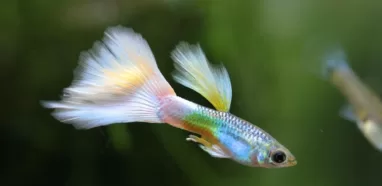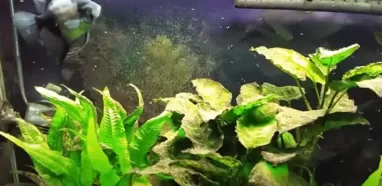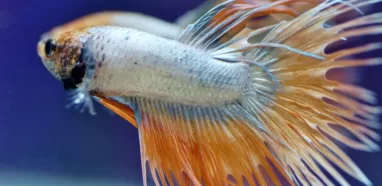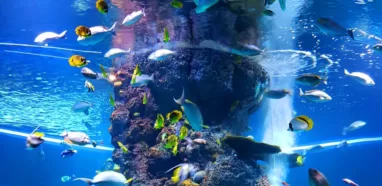All aquarists know that it is never easy to maintain a healthy aquarium. You need to clean the tank, feed your fish, and control and monitor everything. But, one thing that most hobbyists usually neglect is monitoring the lighting hours of their aquarium.
If you have a planted aquarium, the amount of light is something that you can never take for granted. Aquarium lights play a role far bigger than just providing light in the aquariums. The lights have a great impact on lives within the fish tank and it can be said that lights play one of the most integral parts when it comes to the overall health of the aquarium.
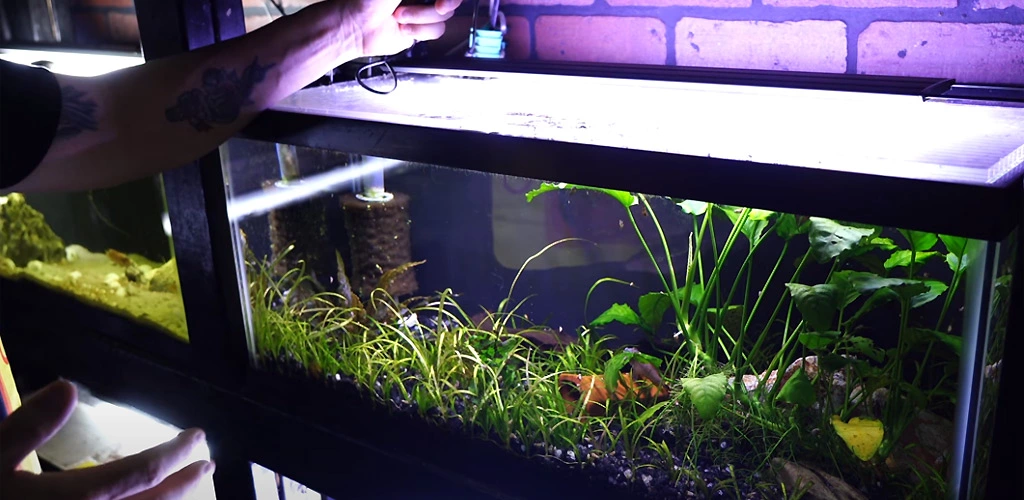
The amount of light provided to the planted aquarium determines the health and comfort of fishes, the speed at which bacteria or algae will grow, and the growth and health of aquarium plants as well. So, how many hours of light do aquarium plants need? For how long should aquarium lights be on?
There are different types of plants that are used as aquarium plants. One thing is common that they all have to live and grow on the artificial light in the planted aquarium. This should be done with great care because providing light for a relatively long time can cause damages to the plants and may kill them completely as well.
Plants require light for the process of photosynthesis and these needs can differ from one plant type to another. First, we need to understand and know about the major types of plants used in aquariums.
Table of Contents
Specific types of aquarium plants
This is probably the most crucial factor to consider there. Plants need light for photosynthesis, the process for them to get the food they need to survive.
Plants need lots of light for this process to take place. There are plants that need up to 12 hours of light daily to flourish and stay healthy in the aquarium.
But, don’t forget that all plants have unique requirements. The exact amount of light a plant needs daily depends on its size and type. There are three types of aquarium plants that aquarists should be familiar with.
Carpet Plants
These plants are those found at the bottom of the tank. These generally cover the aquarium’s base like a carpet. Carpet plants need a medium to high light to thrive at the bottom.
These plants can be very demanding so you might need to leave the light on for 12 to 14 hours for them to stay healthy.
There are two popular types of carpet plants – lilaeopsis and dwarf baby tears.
- Lilaeopsis: It is a well-known and much-appreciated plant in carpet categories and can live healthy while growing efficiently in both medium and high light conditions. This plant is an ideal choice if you want to create a balance between the light required by fish and Lilaeopsis in the aquarium because this plant will be able to grow properly even in a moderate amount of light as well. This will allow you to keep the light ON for a little less than 12 hours a day.
- Dwarf Baby Tears: These plants can grow in small aquariums as well and have beautiful and charming looks. Even if this plant can grow in small aquariums at the bottom, it does require a lot of light to survive. Make sure that you provide them with proper light for a minimum of 12 hours a day.
Mid-Ground Plants
These plants are often low maintenance and they need low to moderate amounts of light. Eight hours o light daily should be sufficient for the plants to flourish and grow well in the aquarium. For proper growth and flourishing of these plants, keeping the light ON for up to 8 hours is considered enough and efficient.
The best thing about these plants is that they will allow you to enjoy a comfortable experience because of less maintenance while adding a great charm to your aquarium. Some of the most popular and recommended mix-ground plants include:
- Pygmy Chain Sword: An ideal choice if you’re fond of growing grass inside your aquarium. This is because the plants look a lot similar to the normal grass and give an appealing look. Their beauty, charm, and aesthetics are the basic reasons that make this plant stand out in various options. They need soft and less light to stay healthy and grow in the proper way.
- Green Tiger Lotus: This is a beautiful plant that doesn’t require much care and maintenance. This plant can survive adorably as it is self-sufficient in good aquarium conditions. These plants require a moderate amount of light, neither too little nor too much.
Background Plants
No doubt aesthetics and beauty are major parts of the background plants but these plants are widely used to hide different aquarium equipment/components. It is also used to provide a hiding place for fishes especially the catfish and it is used for increasing the depth of the aquarium as well.
Although these types of plants are widely used as they require little maintenance and bring a full-fledged package of beauty and charm, they may have a special need for light to live and grow properly. Most appreciated and widely used types of background plants include the following.
- Pondweed: This plant is fond of high light and grows extremely well in a large amount of light. Although it can live in moderate light as well and people think that it is ideal for them, you can only get benefits from its actual beauty and aesthetics if you provide proper light to this plant.
- Amazon Sword: Even if it is a background plant, it has the ability to live and grow at medium as well as low lighting without any major issues. If you add this plant to your aquarium, it provides you with the advantage as you will not have to purchase and implement an expensive and high-intensity lighting system.
Ambient light in the room
Ambient room lighting is another crucial factor you need to consider. If you have an outdoor planted aquarium or this is placed in an area that gets lots of natural light, chances are your aquarium won’t need artificial lights at all.
But, take note that ambient lighting in the room is indirect so your planted aquarium will be better off with an artificial light.
An aquarium placed in a brightly lit space will have considerably lower lighting requirements. This means that an aquarium in a room with sufficient ambient light will not necessarily require 8 to 12 hours of artificial light. It would be enough to keep the lights on for just a few hours per day.
Algae Growth
One of the contributing factors for algae blooms in aquariums is none other than light. Excessive algae might cause some problems.
To know if you are using the right light settings, you might want to check the aquarium’s algae level. if there is a higher than normal algae level, chances are you have been keeping the lights on for longer than necessary.
Remember that sunlight can produce more algae compared to artificial light. So if you have an outdoor planted aquarium or you placed it close to a natural light source or a window, you might notice higher algae levels in your aquarium.
Types of Light
The specific types of light you use also play a critical role. There are various choices available and all of them have their own advantages and disadvantages.
One option is a fluorescent bulb, the most common options of which are T5 and T8. While these bulbs both offer enough light for the plants in your aquarium to grow, it is highly recommended to use T5 bulbs since these are more powerful compared to their counterparts.
T5 bulbs are also better choices for planted aquariums with dense populations. In general, one to two bulbs are enough for medium-sized tanks based on the plants’ specific light requirements.
LED lighting is also another option. These are equally powerful and more affordable at the same time. These lights can also last for as much as five years. But, you might need to install more LED lights than fluorescent bulbs.
LED lights also have better aesthetics and offer stunning lighting effects for aquariums.
The Bottom Line
These are the factors that help you identify the daily light requirements for planted aquariums. A very helpful tip is to ensure that your lights are turned off for the most part of the day if you have a newly planted aquarium. It will help minimize algae growth and ensure that your plants remain comfortable inside the aquarium.
While you might find it overwhelming at first, knowing how long you should leave the lights on in your planted tank is not really that difficult.
There might be lots of considerations but when you get used to all of it, things will be easier and you can be sure that your plants will grow and thrive in your aquarium.
We also recommend you to read:
